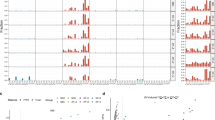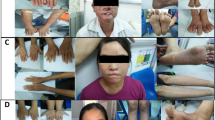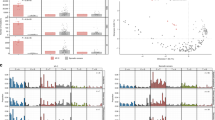Abstract
PATIENTS with the inherited disease, xeroderma pigmentosum (XP), are subject to multiple carcinomas of the skin on areas exposed to sunlight1. Fibroblasts from the skin of the majority of these patients (classical XP) have been shown to be deficient in excision repair of lesions induced in DNA by ultraviolet radiation1–3. One group of patients, however, has been designated ‘XP variants’ because, although they suffer the clinical manifestations of the disease, they carry on normal excision repair of such ultraviolet-light damage to DNA4–6. Lehmann et al.6 reported that cells from such XP variants are abnormally slow in converting initially low molecular weight DNA, synthesised after ultraviolet irradiation, into high molecular weight DNA similar in size to that produced in unirradiated cells. Although these authors suggest that such abnormal DNA replication might explain why such patients are susceptible to cancer of the skin, they do not propose any mechanism. If the somatic cell mutation hypothesis on the origin of cancer, first suggested by Boveri7, is correct one would expect the frequency of mutations induced by ultraviolet light to be higher in cells derived from skin biopsies from both classical and variant XP patients than in cells from normal persons. To test this hypothesis, we have carried out a series of quantitative investigations comparing the frequency of ultraviolet-light induced mutations to azaguanine resistance in normal human skin fibroblasts with that found in various strains derived from classical and variant XPs. We have found that cells derived from both kinds of XP patients indeed show much higher frequencies than normal cells. The data comparing two classical XP strains with normal cells have been published8,9. Here, we present data obtained with variant strain, XP4BE.
This is a preview of subscription content, access via your institution
Access options
Subscribe to this journal
Receive 51 print issues and online access
$199.00 per year
only $3.90 per issue
Buy this article
- Purchase on Springer Link
- Instant access to full article PDF
Prices may be subject to local taxes which are calculated during checkout
Similar content being viewed by others
References
Robbins, J. H., Kraemer, K. H., Lutzner, M. A., Festoff, B. W., and Coon, H. G., Ann. Intern. Med., 80, 221–248 (1974).
Cleaver, J., Nature, 218, 652–656 (1968).
Burk, P. G., Yuspa, S. H., Lutzner, M. A., and Robbins, J. H., Lancet, i, 601 (1971).
Cleaver, J., J. Invest. Dermat., 58, 124–128 (1972).
Kleijer, W. J., et al., Mutat. Res., 20, 417–428 (1973).
Lehmann, A. R., et al., Proc. natn. Acad. Sci. U.S.A., 72, 219–223 (1975).
Boveri, T., The Origin of Malignant Tumors (first published Jena, 1914), (Williams and Wilkins, Baltimore, 1929).
Maher, V. M., and McCormick, J. J., in Biology of Radiation Carcinogenesis (edit. by Yuhas, J. M., Tennant, R. W., and Regan, J. B.), 129–145 (Raven, New York, 1976).
Maher, V. M., Curren, R. D., Ouellette, L. M., and McCormick, J. J., in Fundamentals of Cancer Prevention (edit. by Nakahara, W., Takayama, S., and Sugimura, T.), (Plenum, New York, in the press).
Maher, V. M., Birch, N., Otto, J. R., and McCormick, J. J., J. natn. Cancer Inst., 54, 1287–1294 (1975).
Maher, V. M., Ouellette, L. M., Mittlestat, M., and McCormick, J. J., Nature, 258, 760–763 (1975).
Albertini, R. J., and DeMars, R., Mutat. Res., 18, 199–224 (1973).
Maher, V. M., and Wessel, J. E., Mutat. Res., 28, 277–284 (1975).
Van Zeeland, A. A., and Simons, J. W. I. M., Mutat. Res., 34, 149–158 (1976).
Lehmann, A. R., Life Sci., 15, 2005–2016 (1975).
Painter, R. B., Genetics, 78, 139–148 (1974).
Higgins, N. P., Kato, K., and Strauss, B., J. molec. Biol., 101, 417–425 (1976).
Author information
Authors and Affiliations
Rights and permissions
About this article
Cite this article
MAHER, V., OUELLETTE, L., CURREN, R. et al. Frequency of ultraviolet light-induced mutations is higher in xeroderma pigmentosum variant cells than in normal human cells. Nature 261, 593–595 (1976). https://doi.org/10.1038/261593a0
Received:
Accepted:
Published:
Issue Date:
DOI: https://doi.org/10.1038/261593a0
This article is cited by
-
Contributions of replicative and translesion DNA polymerases to mutagenic bypass of canonical and atypical UV photoproducts
Nature Communications (2023)
-
DNA polymerase η modulates replication fork progression and DNA damage responses in platinum-treated human cells
Scientific Reports (2013)
-
DVC1 (C1orf124) recruits the p97 protein segregase to sites of DNA damage
Nature Structural & Molecular Biology (2012)
-
Two-polymerase mechanisms dictate error-free and error-prone translesion DNA synthesis in mammals
The EMBO Journal (2009)
-
Xeroderma Pigmentosum-Variant Patients from America, Europe, and Asia
Journal of Investigative Dermatology (2008)
Comments
By submitting a comment you agree to abide by our Terms and Community Guidelines. If you find something abusive or that does not comply with our terms or guidelines please flag it as inappropriate.



